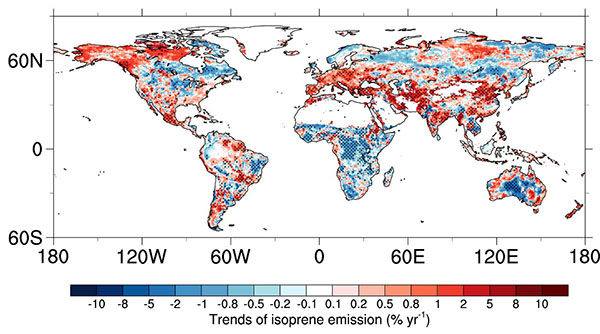Biogenic volatile organic compounds (BVOCs) emitted from vegetation are important precursors to ozone and secondary organic aerosols in the atmosphere, affecting air quality, clouds, and climate. In the context of global vegetation greening and anthropogenic emission reductions, the significance of natural sources is increasingly apparent. However, BVOC emissions remain highly uncertain as they depend on a diversity of factors, and the relative importance of different factors is still unclear.
A recent study conducted by a team of scientists from Institute of Atmospheric Physics at the Chinese Academy of Sciences and Texas A&M University and published in the journal
Atmospheric Chemistry and Physics has simulated regional to global changes in BVOC emissions over the past two decades using the latest BVOC emission model, MEGANv3.2. The study quantifies the contributions of different drivers, such as vegetation, meteorological parameters, and carbon dioxide concentration, to the trends in BVOC emissions.
Figure 1 Spatial distribution of isoprene emission trends from 2001 to 2020. (Image by Wang et al.)
The results reveal that BVOC emission trends vary among different regions. While global greening trends significantly boost BVOC emissions, deforestation, coupled with the rapid expansion of agriculture, reduces BVOC emissions in South America and Southeast Asia. Elevated temperatures in Europe and increased soil moisture in East and South Asia contribute to BVOC emissions' rise in these regions.
"This study enhances our understanding of long-term BVOC emission trends at regional to global scales," noted Prof. Xiaohong Liu, the corresponding author of the study. "These findings also provide an important reference for the projection of future BVOC emission trends."
Reference:
Wang, H., Liu, X., Wu, C., and Lin, G.: Regional to global distributions, trends, and drivers of biogenic volatile organic compound emission from 2001 to 2020, Atmos. Chem. Phys., 24, 3309–3328, https://doi.org/10.5194/acp-24-3309-2024, 2024.

